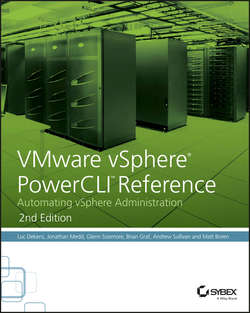VMware vSphere PowerCLI Reference

Реклама. ООО «ЛитРес», ИНН: 7719571260.
Оглавление
Graf Brian. VMware vSphere PowerCLI Reference
Copyright
Credits
Dedication
Acknowledgments
About the Authors
Introduction
Part I. Install, Configure, and Manage the vSphere Environment
Chapter 1. Automating vCenter Server Deployment and Configuration
Chapter 2. Automating vSphere Hypervisor Deployment and Configuration
Chapter 3. Automating Networking
Chapter 4. Automating Storage
Part II. Managing the Virtual Machine Life Cycle
Using Advanced vSphere Features
Chapter 6. Creating Virtual Machines
Chapter 7. Using Templates and Customization Specifications
Chapter 8. Configuring Virtual Machine Hardware
Chapter 9. Advanced Virtual Machine Features
Chapter 10. Using vApps
Part III. Securing Your vSphere Environment
Chapter 11. Backing Up and Restoring Your Virtual Machines
Chapter 12. Organize Your Disaster Recovery
Chapter 13. Hardening the vSphere Environment
Chapter 14. Maintain Security in Your vSphere Environment
Part IV. Monitoring and Reporting
Chapter 15. Reporting and Auditing
Chapter 16. Using Statistical Data
Chapter 17. Alarms
Part V. Integration
Chapter 18. The SDK
Chapter 19. vCloud Director
Chapter 20. vCloud Air
Chapter 21. vRealize Orchestrator
Chapter 22. Site Recovery Manager
Chapter 23. PowerActions
Part VI. PowerCLI and DevOps
Chapter 24. Source Control
Chapter 25. Running Scripts
Apendix. Example Reports
Virtual Machines
Guest Operating Systems
Hosts
Clusters
Отрывок из книги
Senior Acquisitions Editor: Stephanie McComb
Development Editor: ME Schutz
.....
Role A role is a collection of privileges. Roles provide a way to add all the individual privileges that are required to perform a number of tasks, such as administering a vSphere host.
Object An object is an item on which actions can be performed. vCenter Server objects are datacenters, folders, resource pools, clusters, hosts, and VMs.
.....